sail to the crib
Last Monday, I decided to have my class sail out to the the Wilson Avenue crib. Sailing to the crib is good practice navigating in large waves -- it also makes the kids more independent and gets them comfortable being further from shore. Getting somewhere on a sailboat is fun, too, instead of just going around buoys.
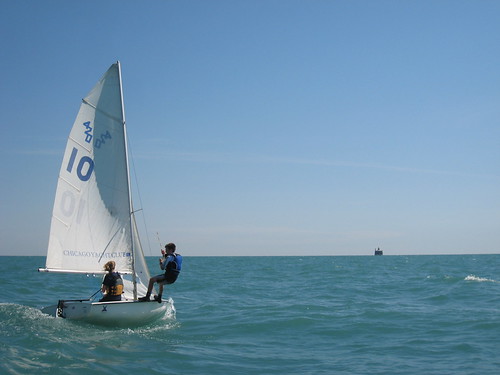 A boat practicing trapezing on the way to the crib.
A boat practicing trapezing on the way to the crib.
Accompanying my sailors in a safety boat, the trip also afforded me a close look at a work of historic engineering. Built in early 1900s, the Wilson Avenue crib is part of the massive hydrological infrastructure that gives Chicago its drinking water. (The most famous part of the system is the Sanitary and Shipping Canal, which reversed the flow of the Chicago River in 1900.)
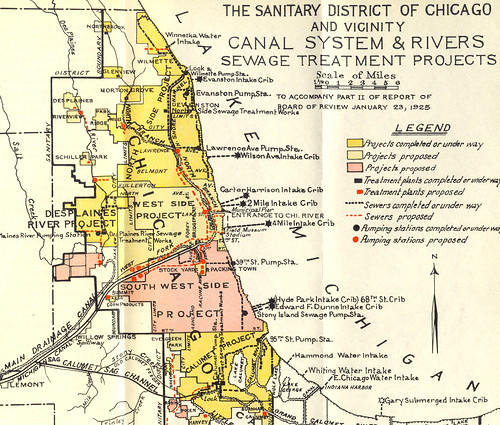 The Chicago Sanitation District, 1925. (Now known as the Metropolitan Water Reclamation District of Greater Chicago.)
The Chicago Sanitation District, 1925. (Now known as the Metropolitan Water Reclamation District of Greater Chicago.)
When operation began in 1866, the first crib pulled clean water through pipes from two miles offshore to a water tower at the corner of Michigan and Chicago Avenues. Meant to equalize water pressure, the water tower gained great fame as one of the few structures to survive the Great Chicago Fire in 1871.
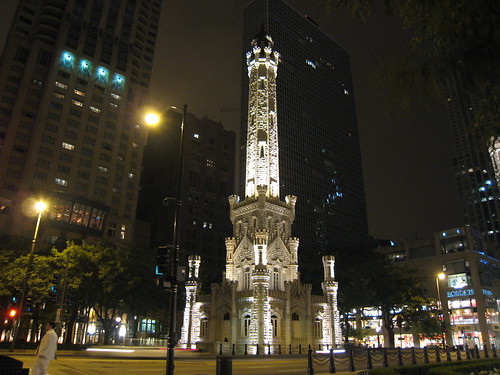 To this day, the land between the water tower (above) and the two-mile crib (which no longer exists) is conspicuously unbuilt -- only the Museum of the Contemporary Art has been built above the old pipes' path.
To this day, the land between the water tower (above) and the two-mile crib (which no longer exists) is conspicuously unbuilt -- only the Museum of the Contemporary Art has been built above the old pipes' path.
Though the original crib is long gone, others, like the Wilson Avenue crib, remain in operation today. These cribs collect lake water and send it ashore to be purified. One of Chicago's chemical purification plants, the Jardine Water Purification Plant, is the largest in the world.
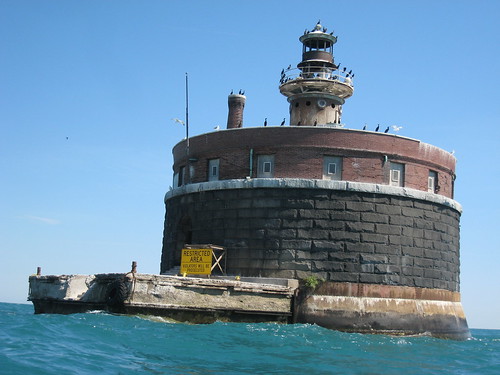 The Wilson Avenue crib, from just beyond the restricted area created after 9/11.
The Wilson Avenue crib, from just beyond the restricted area created after 9/11.
As a place, the crib feels very surreal. In some ways, it's familiar: I see the crib almost every day. At the same time, though, viewing it from the far side -- and from so close -- make being there totally foreign.
 Seeing Chicago's skyline from the crib always makes me feel a bit like an astronaut seeing earth from the moon.
Seeing Chicago's skyline from the crib always makes me feel a bit like an astronaut seeing earth from the moon.
Some of my students call the crib "Azkaban," the wizards' prison from Harry Potter. Although the residents weren't prisoners, the cribs were once inhabited by tenders. Today, however, the systems are automated: no one has lived on the structures for decades.
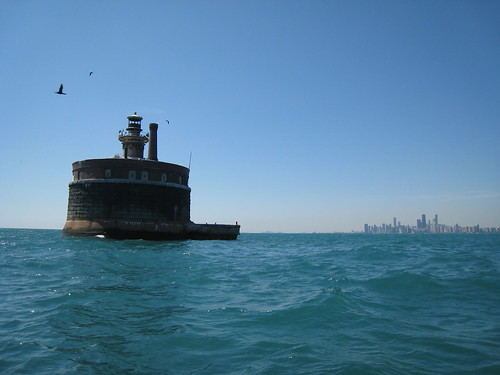
Chicago from the Wilson Avenue crib.
As a waypoint, a historic building, and a place, the crib is fascinating. I always love to sail to the crib.
(Full photoset of the trip here.)
 A boat practicing trapezing on the way to the crib.
A boat practicing trapezing on the way to the crib.Accompanying my sailors in a safety boat, the trip also afforded me a close look at a work of historic engineering. Built in early 1900s, the Wilson Avenue crib is part of the massive hydrological infrastructure that gives Chicago its drinking water. (The most famous part of the system is the Sanitary and Shipping Canal, which reversed the flow of the Chicago River in 1900.)
 The Chicago Sanitation District, 1925. (Now known as the Metropolitan Water Reclamation District of Greater Chicago.)
The Chicago Sanitation District, 1925. (Now known as the Metropolitan Water Reclamation District of Greater Chicago.)When operation began in 1866, the first crib pulled clean water through pipes from two miles offshore to a water tower at the corner of Michigan and Chicago Avenues. Meant to equalize water pressure, the water tower gained great fame as one of the few structures to survive the Great Chicago Fire in 1871.
 To this day, the land between the water tower (above) and the two-mile crib (which no longer exists) is conspicuously unbuilt -- only the Museum of the Contemporary Art has been built above the old pipes' path.
To this day, the land between the water tower (above) and the two-mile crib (which no longer exists) is conspicuously unbuilt -- only the Museum of the Contemporary Art has been built above the old pipes' path.Though the original crib is long gone, others, like the Wilson Avenue crib, remain in operation today. These cribs collect lake water and send it ashore to be purified. One of Chicago's chemical purification plants, the Jardine Water Purification Plant, is the largest in the world.
 The Wilson Avenue crib, from just beyond the restricted area created after 9/11.
The Wilson Avenue crib, from just beyond the restricted area created after 9/11.As a place, the crib feels very surreal. In some ways, it's familiar: I see the crib almost every day. At the same time, though, viewing it from the far side -- and from so close -- make being there totally foreign.
 Seeing Chicago's skyline from the crib always makes me feel a bit like an astronaut seeing earth from the moon.
Seeing Chicago's skyline from the crib always makes me feel a bit like an astronaut seeing earth from the moon.Some of my students call the crib "Azkaban," the wizards' prison from Harry Potter. Although the residents weren't prisoners, the cribs were once inhabited by tenders. Today, however, the systems are automated: no one has lived on the structures for decades.

Chicago from the Wilson Avenue crib.
As a waypoint, a historic building, and a place, the crib is fascinating. I always love to sail to the crib.
(Full photoset of the trip here.)

3 comments:
I am of the opinion that Chicago is the most under-repped major American city in the urbanism blogosphere.
That said, this was lovely.
I'd hate to be a 'tender' - you're right, cribs do seem fascinating and sort of detached from real life, but I don't fancy living there. I doubt the nightlife would've been much to write home about!
Anyway, I understand you work in architecure/planning, so I thought you might be interested in i-Think, a brand new professional networking site for the property, architecture and construction sectors. i-Think is the online community for professionals in the built environment and the only industry network dedicated to stimulating debate on sustainability & regeneration, sharing information and showcasing products and services. So basically like a MySpace for professionals!
i-Think is free to join and use. Go to www.i-think.com to sign up and get involved.
Post a Comment